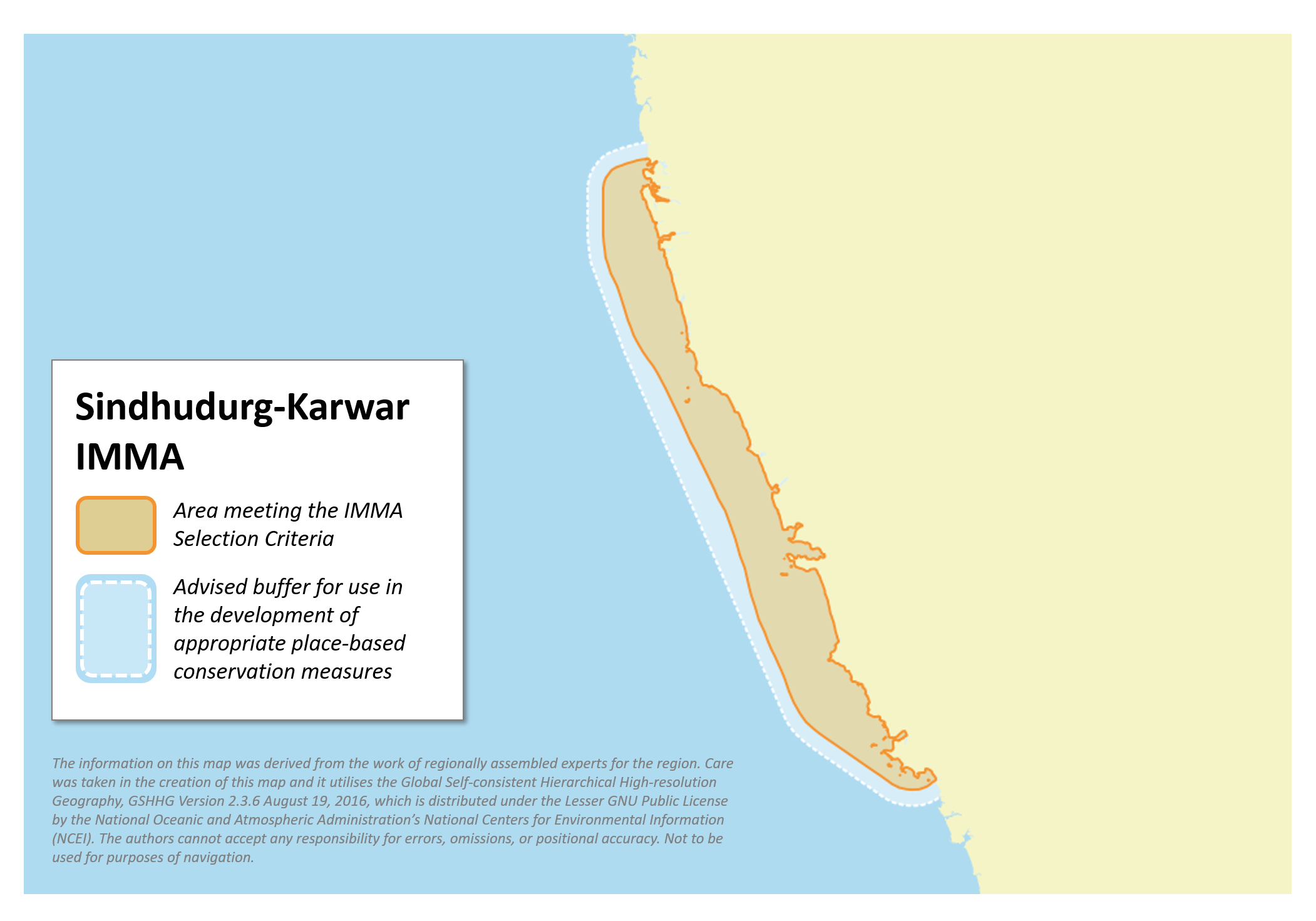Sindhudurg-Karwar IMMA
Size in Square Kilometres
4 327 km2
Qualifying Species and Criteria
Indian Ocean humpback dolphin – Sousa plumbea
Criterion A; B (1)
Indo-Pacific finless porpoise – Neophocaena phocaenoides
Criterion A; B (1)
Marine Mammal Diversity
Criterion D (2)
Balaenoptera musculus, Balaenoptera edeni, Delphinus delphis, Kogia sima, Pseudorca crassidens, Megaptera novaeangliae, Sousa plumbea, Tursiops aduncus, Neophocaena phocaenoides, Orcinus orca, Stenella attenuata, Stenella coeruleoalba
Download fact sheet
Summary
The coastal stretch covering southern Maharashtra (Sindhudurg), Goa and northern Karnataka (Karwar) in India hosts at least 12 species of whales and dolphins. Among these species, Endangered Indian Ocean humpback dolphins (Sousa plumbea) and Vulnerable finless porpoises (Neophocaena phocaenoides) are the most frequently observed. Dedicated cetacean surveys in both Sindhudurg and Goa (Karwar Bay) indicate that these two species are present year-round, and likely resident. Stranding response networks in the area show that the mortality rates of both these species are relatively high, with fisheries bycatch from both artisanal and commercial fisheries presenting the most significant threat. Other species reported from within this species-diverse area include Endangered blue whales (Balaenoptera musculus), Bryde’s whales (Balaenoptera edeni), pantropical spotted dolphins (Stenella attenuata), Indo-Pacific bottlenose dolphins (Tursiops aduncus), common dolphins (Delphius delphis), killer whales (Orcinus orca), humpback whales (Megaptera novaeangliae), dwarf sperm whales (Kogia sima), false killer whales (Pseudorca crassidens) and striped dolphins (Stenella coeruleoalba). The humpback whales observed in this IMMA are part of the Endangered Arabian Sea sub-population, which remains in the Arabian Sea year-round rather than performing long migrations to temperate or polar feeding grounds.
Description of Qualifying Criteria
Criterion A – Species or Population Vulnerability
Sousa plumbea and Neophocaena phocaenoides, are listed as Endangered and Vulnerable respectively by the IUCN Red List. The mortality rates for both species in this region ranged from 6-15 animals per year between 2014-2019 (MMRCNI 2019). These are resident populations that might be showing some local movement within this ~260 km area. New-born calves and juveniles have been observed; different foraging strategies and local movements that have been observed are now being studied by Jog and Bopardikar. In addition, Neophocaena phocaenoides is highly susceptible to a wide range of fishing gear, both artisanal and commercial. The coast is under immediate threat of infrastructure development – thermal power plants, shipping ports, a proposed nuclear power plant and tourism sector projects are all in the pipeline, beyond the expanded commercial fisheries, and mining in the region.
Criterion B: Distribution and Abundance
Sub-criterion B1: Small and Resident Populations
Sousa plumbea and Neophocaena phocaenoides are both present year-round in the area but robust population estimates are not yet available. Based on Photo-ID data close to 600 individual humpback dolphins have been identified in Sindhudurg, while no estimate is available for finless porpoises. These Criteria may be used for Neophocaena in the future after robust estimates are available.
Criterion D: Special Attributes
Sub-criterion D2: Diversity
The area has reported at least 12 species of cetaceans – Indian ocean humpback dolphin, Indo-Pacific finless porpoise, Blue whale, Bryde’s whale, pantropical spotted dolphin, Indo-Pacific bottlenose dolphin, common dolphin, killer whale, humpback whale, dwarf sperm whale, false killer whale and striped dolphin. Most of these species have been reported multiple times other than striped dolphins, false killer whales and dwarf sperm whales. The presence of vocalising humpback whales in this area is of potential significance for the Arabian Sea Humpback whale population.
Supporting Information
Bopardikar I., Sutaria D., Sule M., Jog K., Patankar V., Klinck H. 2018. Description and classification of Indian Ocean humpback dolphin (Sousa plumbea) whistles recorded off the Sindhudurg coast of Maharashtra, India. In Marine Mammal Science DOI:10.1111/mms.12479.
Jamalabad, A and Srinivasan, M. 2017. Fishery and coastal cetacean interactions off Karwar, Karnataka – a step towards understanding a little-known man-wildlife interface at sea. Paper presented at the Students Conference for Conservation Science, Bangalore.
Jamalabad, A. 2016. Fisheries and coastal cetacean interactions, livelihood-based solutions to mitigate impacts and potential conflict in Karwar, India. Report Submitted to the Inlaks Foundation, India.
MMRCNI .2019. Database of records from Maharashtra at http://www.marinemammals.in/database/sightings-and-strandings/
Sule M., Bopardikar I., Jog K., Jamalabad A., Panicker D., Tregenza N., Sutaria D.; A Review of Neophocaena phocaenoides Records from India, With A Special Focus on The Population in Sindhudurg, Maharashtra. A Paper Submitted to the IWC Sub-Committee, May 2017. Sc/67a/Sm/09.
Sutaria, D., and Jefferson, T. A. 2004. Records of Indo-Pacific Humpback Dolphin (Sousa chinensis Osbeck, 1765) along the coast of India and Sri Lanka – An Overview. Aquatic Mammals Special Issue 30(1) 125-136
Sutaria, D., Panicker, D., Jog, K., Sule, M., Muralidharan, R., and Bopardikar, I. 2015. Humpback dolphins (Genus Sousa) in India: an overview of status and conservation issues. In Advances in marine biology, vol. 72, pp. 229-256. Academic Press, 2015.
Sutaria D., Sule M., Jog K., Bopardikar I., Panicker D. 2017. Baleen Whale Records from the Arabian Sea, India. A Note Submitted to the IWC Sub-Committee, May 2017. SC/67a/CMP/03


